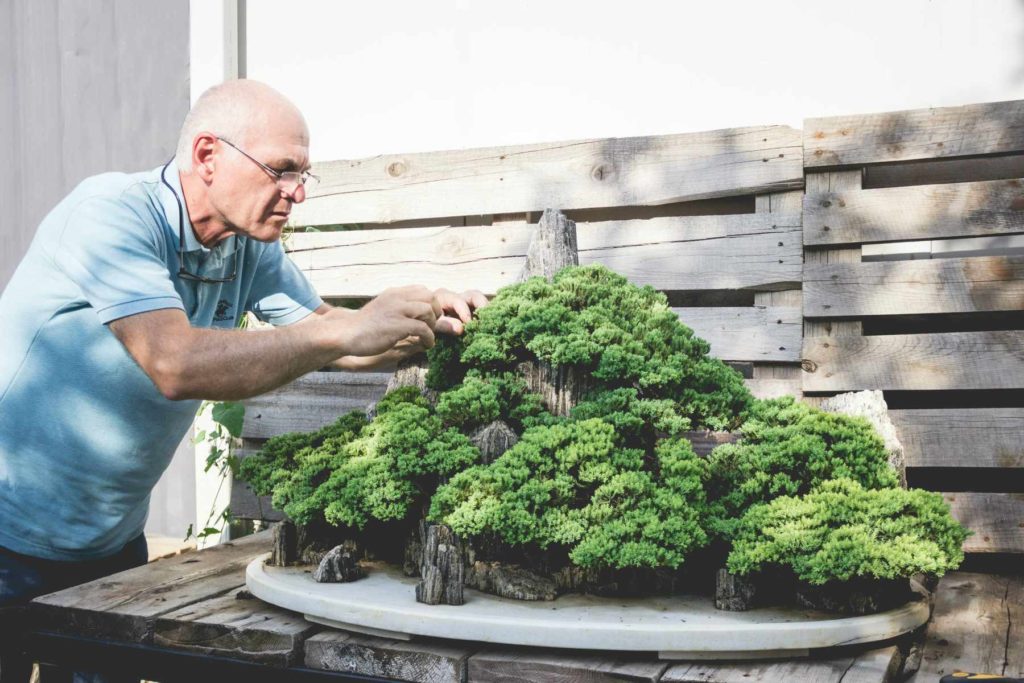Spruce (Latin: Picea)
Spruce is an evergreen, tall tree (20-30 meters) from the pine family. In Georgia, only one species is found: the Eastern Spruce (*Picea orientalis*). Other species that are present in the region include the European Spruce (*Picea excelsa*) and the Himalayan Spruce (*Picea morinda*). The spruce tree grows slowly for the first 15-20 years and then accelerates in growth. It is shade-tolerant and resistant to frost, with a lifespan of 250-300 years.
Bonsai Styles for Spruce: Chokanni (直幹), Shakani (斜幹), Moiyogi (模様木), Han-Kengai (半懸崖), Yose Ue (寄せ植え)
Article on Bonsai Styles
Location: Place the spruce in partial shade. During hot summer days, protect it from direct midday sunlight. It is quite frost-resistant, down to -10°C, and does not require protection from frost.
Fertilizer: Once every three weeks during the growing season.
Watering: The soil should be moist, not waterlogged. In winter, watering is less frequent. However, complete drying of the soil should be avoided.
Repotting: For spruces under 10 years old, repot every 2 years. Repotting should be done in early spring, before the buds open. When repotting, trim up to one-third of the root mass. Older spruces should be repotted every 4-5 years. It is recommended to plant a spruce bonsai in a deeper container relative to its size.
Pruning: Trim larger branches in the fall. The buds develop on the previous year's growth and are located at the tips. For branches you don't want to grow longer, remove the buds in the fall. To maintain shape, when the newly sprouted needles reach 3-4 cm in length, pinch or "nip" 2/3 of their length. Without pruning, the majority of the needles will only grow at the tips of the branches, and the rest will remain almost needleless.
Wiring: Wiring should be done only in late autumn or winter. Wiring during spring or summer may damage the branch. Spruce trees have quite flexible branches. To secure a branch in the desired position, the wire should stay on large branches for at least 5-6 months. It may need to stay even longer. To prevent damage, it is often necessary to remove the wire frame and rewire the branch a year later.

Propagation: Sowing occurs in the spring. Propagation by cutting is done in late summer, but it takes a long time for rooting to occur. Due to slow growth at an early age, the best option for making bonsai is purchasing from a nursery.
Spruce has a bad reputation for bonsai formation: it is difficult to wire the branches into the desired position. Achieving good branching is also challenging. Very often, the formation of the seedling ends unsuccessfully. However, experienced specialists, taking into account the peculiarities of the spruce, are still able to create a beautiful specimen.
Juniper (Latin: Juniperus sabina)
Juniper, an evergreen, coniferous small tree or shrub from the Cypress family. It grows to a height of 6-10 meters, with a grayish bark. Growth and trunk thickening occur relatively slowly. The needles are 1-2 cm long, sometimes stiff and spiny. Needle color can vary between green, blue, gray, and even yellow on different varieties. It lives for 600-3000 years. It is not demanding in terms of soil. The root system is strong and grows deep into the ground. In Georgia, the following species are found: Long-needled juniper (Juniperus oblonga), Kazakh juniper (Juniperus sabina), a low sprawling shrub with a height of 1.5 meters; Pygmy juniper (Juniperus pygmaea) found only in Adjara, in alpine and subalpine zones; Black juniper (Juniperus foetidissima), and many-fruited juniper (Juniperus polycarpous). There is also another species, spreading juniper (Juniperus procumbens). This variety can be purchased in specialized plant shops. Spreading juniper is particularly ideal for styles such as Kengai (懸崖), Han-Kengai (半懸崖), and Ishitsuki (石付).
Juniper has several advantages for bonsai enthusiasts: ease of growth, easy shaping, and it tolerates pruning and wiring well. Due to the small size of its needles, any size bonsai can be created from it.
Bonsai styles for juniper: Kengai (懸崖), Han-Kengai (半懸崖), Ishitsuki (石付), Fukinagashi (吹き流し), Bankan (蟠幹)
Location: Place the juniper in a sunny spot. It prefers dry environments. It tolerates direct sunlight well, and is quite frost-resistant. However, during harsh winters, it is recommended to protect the bonsai and its roots from the cold.
Watering: Juniper is not one of those plants that require a lot of water. Therefore, water it only after the soil in the container has dried out. High humidity in the environment is also not recommended.

Fertilizing: Once every 3 weeks, from spring to the end of September.
Transplanting: Once every 3-4 years, the most favorable period is late winter, early spring. Trim 1/3 of the roots during transplantation. Root washing is not allowed.
Pruning: Pruning of branches is done in spring or autumn. As mentioned, junipers grow rather slowly. Therefore, avoid attempting to change growth direction by trimming the branches; it is better to achieve this with wire wrapping. Maintenance pruning is required throughout the growing season for some varieties; new shoots should be pinched. Start pinching about a month after the new growth appears. Make sure to remove dry needles and inner branches from the canopy.
Wire Framework: It is preferable to apply wire during the growing season, but it can be done at any time of the year if necessary. The wire should remain on the juniper for 4-5 months.
Propagation: Juniper is primarily propagated through seeding. It can also be propagated by layering and cuttings. The growth rate is quite slow, and it takes significant time to achieve a seedling of the desired size. Purchasing from a nursery is recommended.

